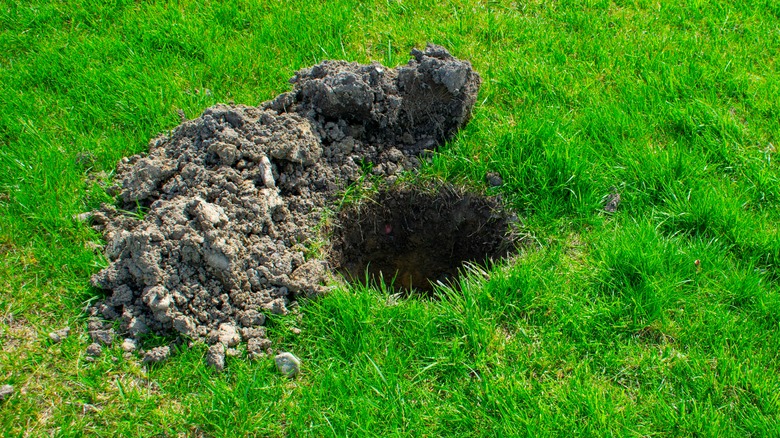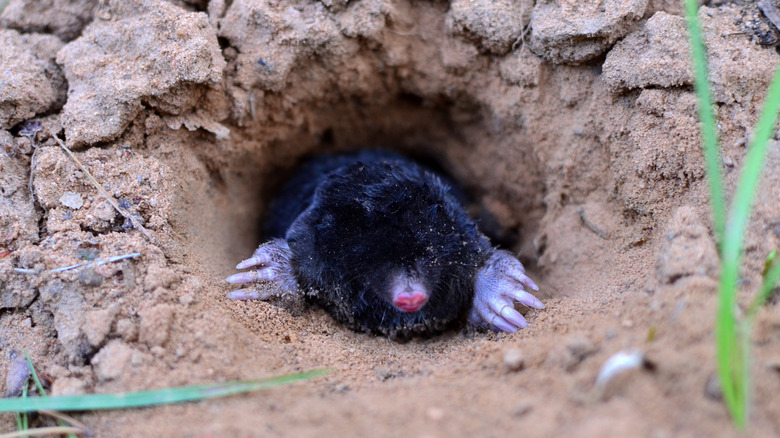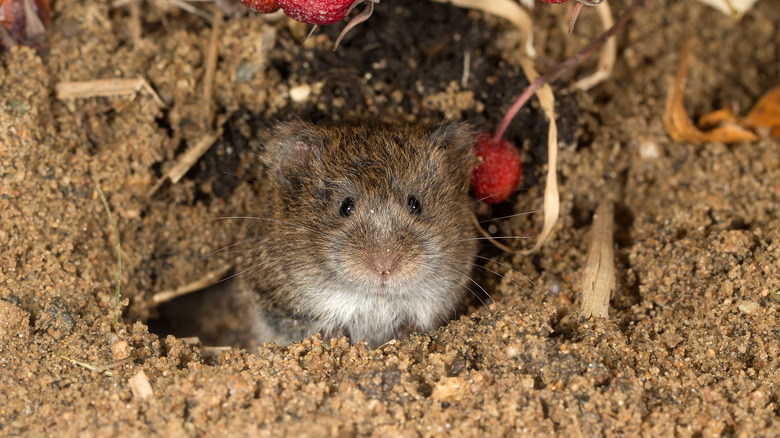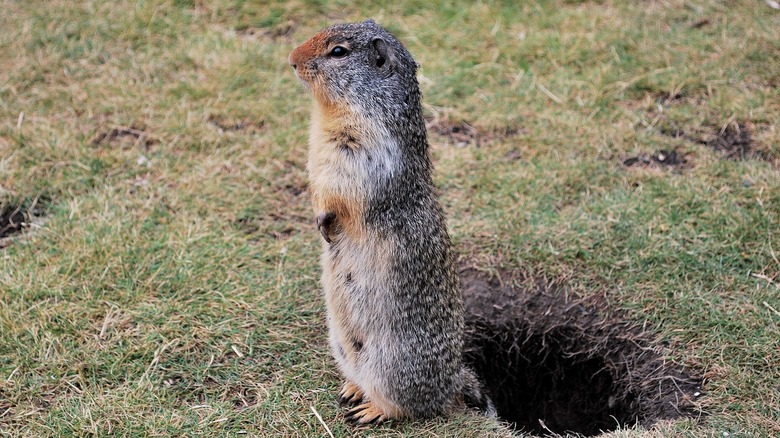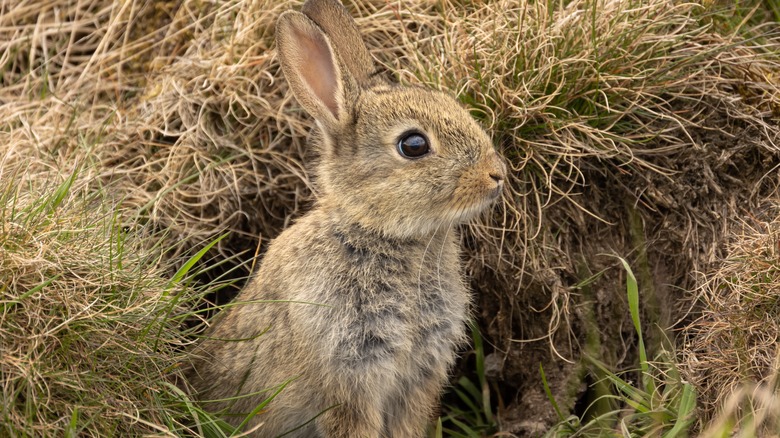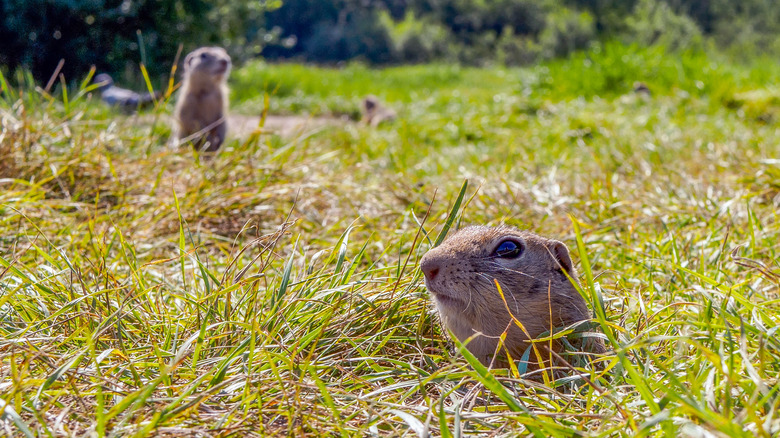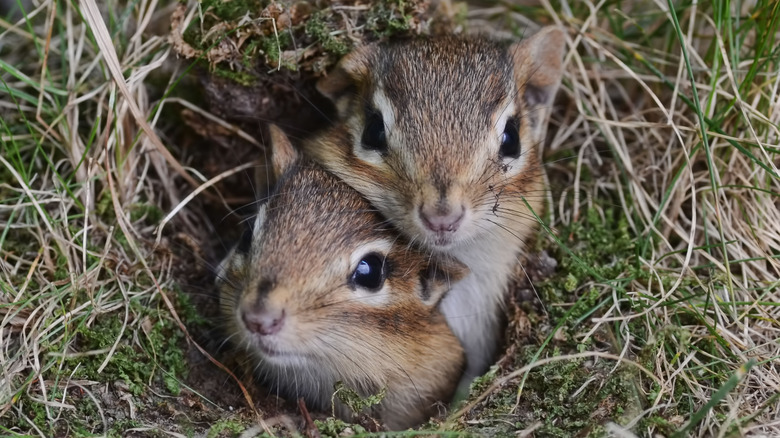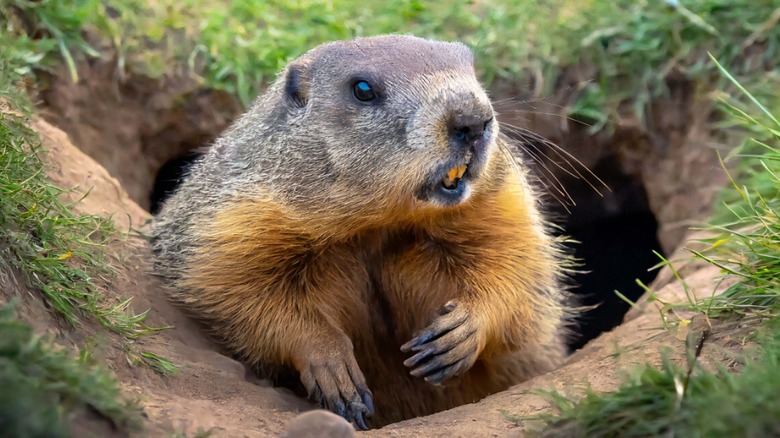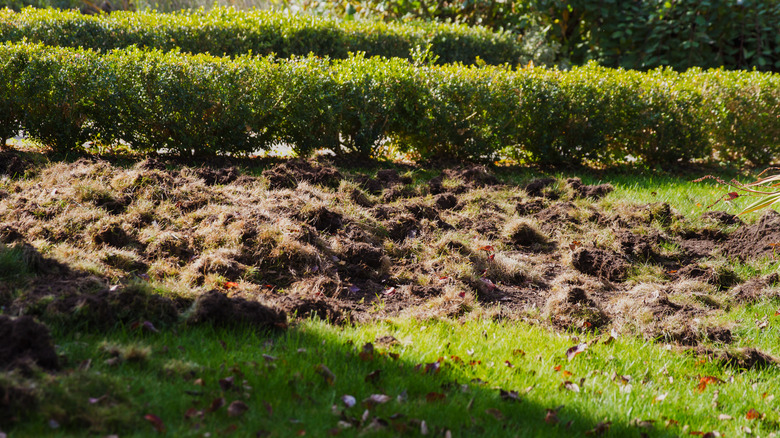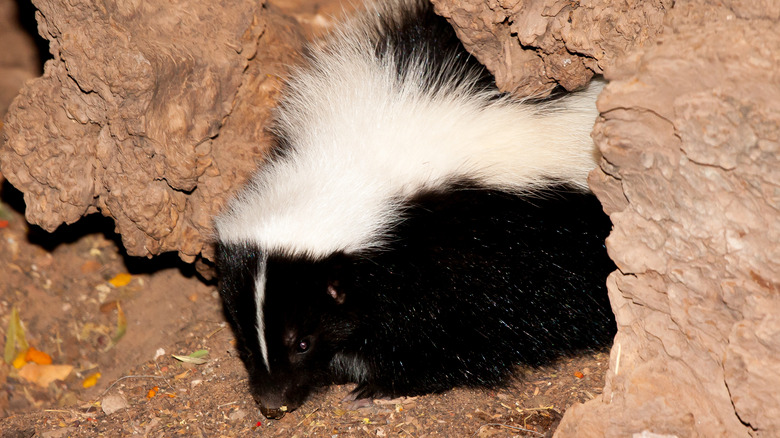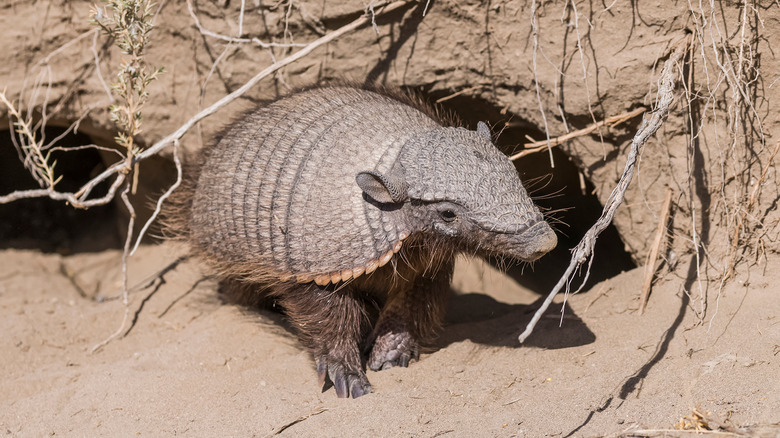How To Tell Which Pest Is Creating Holes In Your Yard (And How To Fix The Damage)
If you've spotted mysterious holes and tunnels in your yard, it's like stepping into a wildlife detective story. Each hole you see, varying in size and shape, is a clue pointing to different backyard critters, offering a small glimpse into their world. It's pretty intriguing to think about these creatures and their daily routines. Animals dig for a myriad of reasons. Some are in search of food, unearthing insects or roots that lie beneath the soil's surface. The soil is a treasure trove of nutrients, housing all vital food sources, and digging allows them access to these hidden nutritional gems, playing a pivotal role in their survival. But it's not just about foraging for food. For some animals, digging is an essential part of creating a safe habitat. Burrows and holes serve as shelters, offering protection from predators and harsh weather conditions. These underground havens become crucial for nesting, rearing young, and hibernating through the colder months. Moreover, certain animals use digging as a strategic tool for storing food. They meticulously bury their finds, ensuring a stash for leaner times.
In short, the art of digging is an instinctual behavior for many animals, driven by their need to feed, protect, or simply survive. Interestingly, the size, depth, and location of the holes can offer hints about the digger's identity and purpose. While you may not always see these animals, their digging activities can offer some clues.
Moles typically create tunnels about 2 inches wide with depths of 27.5 inches
Moles are notorious for creating extensive tunnel networks. They are usually about 2 inches wide, and can extend 27.5 inches deep into the ground. When they dig, they usually push up the soil, forming those characteristic molehills. These mounds of earth are often the first clue to their presence. They are solitary and mostly nocturnal, which means they do most of their work unseen under the cover of darkness. If you're curious about whether you have active moles, here's a tip: flatten a section of a mole tunnel and check back the next day. If the flattened section is repaired, that's your cue that the tunnel is still in use.
Luckily, mole hills tend to go away on their own. But if you'd rather deal with the damage early, you can fill the hole by leveling out the mounds of dirt with a shovel. Just ensure the burrow is empty before closing it off. You can also build a deep underground fence that extends several inches above the ground and digs at least two feet into the soil, creating a barrier that moles can't easily bypass. Alternatively, you can deter moles by regularly letting your pets roam the yard. Their presence, noise, and scent make the area less appealing. Remember, while moles might be a nuisance, they're also a part of the ecosystem, doing their bit in their own mole-ish way. Understanding their habits and habitat preferences is key to coexisting with these intriguing little diggers.
Voles create tunnels 2 inches wide and 12 inches deep
Voles, often confused with their subterranean cousins, the moles, are quite the landscapers in their own right. Unlike moles, vole tunnels aren't as deep. They consist of runways with numerous burrow openings that are around two inches wide. You're more likely to notice them in the springtime. If you look closely, you'll see that voles keep their pathways clear and often trim the nearby plants very short. But not all voles are the same; woodland voles, for instance, shy away from surface runways, opting instead for underground tunnels.
Generally speaking, voles can be quite the troublemakers. They love munching on grasses, bulbs, and plant roots, which can leave your lawn looking patchy and your garden plants damaged. You might also notice their distinct chew marks on the plants and stems. Also, keep in mind that they are active throughout the day, so you might catch them in action during your garden strolls. When it comes to managing vole holes, just like with moles, you'll need to fill the tunnels with soil. However, if the moles are too much, try using EPA-approved rodenticides, which can be effective in getting rid of voles, but be sure to read the instructions and use them carefully.
A gopher's burrow is around 3½ inches in diameter and up to 12 inches deep
Mounds of fresh soil could also be the work of gophers. These little excavators create burrows with diameters ranging from 2½ to 3½ inches. But the true extent of their underground empire is often hidden. Their foraging tunnels typically reside 6 to 12 inches under the ground. Gophers are quite a secretive bunch. They cleverly close their burrow entrances with soil plugs, maintaining a concealed tunnel network. They connect their subterranean domains to the world above through gently sloping side tunnels. These critters are active throughout the year, during both daylight and nighttime hours, yet they seldom venture out of their burrows.
So what can you do about the damage caused? Well, you can fill gopher holes with expanding soil. This type of soil is compact and nutrient-dense, and it has the ability to swell when water is added. First, find all the gopher holes, break the expanding soil into manageable pieces, and place them into the holes. After adding a little water, the soil will expand and completely fill the holes. Besides filling holes, you'll also need to prevent future gopher invasions, which calls for some ingenuity. You can build a protective barrier around plantings using mesh wire. This barrier should be installed deep enough, with a portion bent outward, to prevent gophers from digging underneath. If it's too much work, you can also use a trap like the Gophinator and Macabee, which are designed to capture these rodents.
Rabbits dig burrows that are six inches in diameter.
Rabbits are quite savvy with their burrow designs. Their entry points, usually about six inches wide, are part of a more extensive network, sometimes stretching over several feet. This variation in length allows them to create a complex system of tunnels. The females often do the heavy lifting in terms of digging. They meticulously prepare these burrows, especially when creating a space to nurture their young. With rabbits capable of producing multiple litters per year, each comprising between 3 and 6 kits, the population can grow rapidly.
To fix the damage caused by rabbits, you can fill the holes using dirt, concrete, sand, or rock. Once done, consider using a two-tier approach to managing rabbits in your garden. As with the previous pests, erecting a fence can effectively keep rabbits at bay. For an added layer of protection, plant-based repellents are useful. You can plant herbs like lavender or ivy, which rabbits are not particularly fond of.
Whichever method you choose, rabbits may be protected under local wildlife regulations. It's important to understand these laws before taking any action. It's always best to consult with local environmental or wildlife conservation experts for guidance on humane and legal methods for rabbit control.
Squirrel holes two-inch-wide entrances and are usually up to 30 feet long
If you're noticing small holes about two inches wide in your yard, you might be hosting squirrels. Unlike the more discreet burrows of rabbits or the underground networks of moles, squirrel holes are quite shallow. However, in the case of ground squirrels, their holes are usually up to 30 feet long, a testament to their industrious nature. Squirrels are active during the day, so it's not uncommon to see them scampering around your yard. They have a keen sense of curiosity and can be quite bold in their explorations. Beyond spotting holes, there are other ways to identify squirrel activity. One way is to look out for chewed tree bark. It's even more telling if the affected trees are near the area of the hole. Also, look out for ransacked bird feeders or scattered nuts.
Just like with rabbits, you can use sand, dirt, or concrete to fill the holes. To discourage them from coming back, consider using a squirrel-proof bird feeder. These feeders are designed to keep squirrels out while allowing birds to feed. Planting flowers that squirrels dislike can be another effective strategy. For instance, daffodils contain a toxin that makes them inedible to squirrels, serving as a natural deterrent.
Chipmunk holes are typically one and two inches wide and are neatly excavated
Chipmunk holes in your yard are usually small, about one to two inches wide at the entrance, but usually get wider as you go deeper. Their burrows extend as deep as 3 feet and usually have no soil around them. This cleanliness is due to chipmunks' unique habit of carrying soil away in their cheeks while digging. This behavior sets them apart from other yard animals like squirrels or rabbits, who tend to leave more evidence of their digging activities. Luckily, chipmunks are active during the day, mostly foraging for food, so you won't have a problem spotting them.
Controlling chipmunk populations in your yard can involve several strategies. A quick fix for their holes is to fill them with potting soil, level it with the ground, and then tamp it down. To prevent future digging in the same spot, mixing gravel with soil can make the area less appealing for them to excavate. Other ways to deter chipmunks include removing potential food sources like birdseed spills and keeping your garden tidy to reduce hiding spots. Using natural repellents, such as peppermint oil, may also help discourage them from settling in your yard. Remember, as with other critters, chipmunks are a part of the local ecosystem, so finding a balance between control and coexistence is key to maintaining a healthy garden environment.
Groundhogs dig burrows between 10 to 12 inches in diameter with no more than four entrances
Groundhogs, also known as woodchucks, create burrows that are quite distinctive in your yard. Since they are quite large in size, the entrances of their burrows typically range from 10 to 12 inches in diameter, with up to four entrances. This multi-entrance design is another unique feature that sets them apart. Their burrows are also known for causing structural damage in some areas. Groundhogs are diurnal, meaning they are most active during the day. They are particularly busy in the early morning and late afternoon.
The Humane Society of the United States recommends eviction as the best method for managing groundhogs. Before sealing any burrows, it's essential to clear all vegetation and cover around the entrance. Digging around the entrance a bit and adding substances with a strong scent, like used kitty litter, can effectively deter them. This method utilizes the scent of predators to encourage groundhogs to stop burrowing and vacate. Once you're sure they've left, seal the entrance. However, as groundhogs may return, installing a fence buried at least one foot deep around the area can provide long-term prevention.
Raccoon holes typically measure 3-4 inches across, are shallow, and cone-shaped.
When you spot raccoon activity in your yard, it's quite different from finding the burrows of other animals. Raccoons don't create underground homes; instead, they dig in search of food. Their digging results in cone-shaped, shallow holes about 3 to 4 inches in diameter. You might also notice chunks of sod that have been pulled out and flipped over, a classic sign of raccoons foraging for grubs or insects. Raccoons are larger than many other yard animals and are known for their dexterity and intelligence. Besides the unique holes, they can make their way into other areas of your yard and home. Watch for overturned garbage cans or disturbed compost piles. The damage often extends beyond the yard; they can even make their way into attics or crawl spaces. Since they are primarily nocturnal, most of their mischief happens at night.
Just as with the previous animals, filling raccoon holes is straightforward. Pour concrete into the holes and seal them. To further deter raccoons from your yard, a proactive approach is needed. Remember, they are clever and can be persistent, so a combination of strategies might be necessary for effective control. Your first step is to get rid of the grubs. You can do this by using nematodes, which prey on the grub. Using predator urine of bobcats and wolves is another clever strategy.
Skunk holes are about 3 to 4 inches wide and show up as overturned soil patches
Just like raccoons, skunks are primarily nocturnal animals. They venture out at dusk to feed and are more active at night. During the day, they usually stay hidden in their dens. In your yard, you might come across two types of skunk holes. Firstly, there are shallow holes, about 3 to 4 inches wide, that skunks dig while hunting for insects. These appear as small, overturned soil patches. Skunks are meticulous in their search for food, often removing insects in an organized manner. The second type is larger holes, which skunks excavate to create their dens. The damage they cause in yards, apart from digging, can include pilfered garbage and disturbed pet food. To identify skunk presence, apart from the holes, watch for their unique odor, tracks, or scattered food debris.
To cover the holes, use some topsoil. However, when approaching a potential skunk den, it's important to ensure it's not occupied. Like with groundhog dens, loosely fill the skunk den with soil, straw, or leaves and check the next day. If the debris is cleared, a skunk is likely using the den. To prevent skunks from returning, it helps to eliminate grubs from your lawn. Also, try to properly secure garbage cans and cover areas of your yard with bird netting to deter them from digging. Remember, skunks play a role in controlling insects and rodents, so while their presence might be inconvenient, they also contribute to the ecological balance.
Armadillos holes typically measure up to 24 feet across and have a depth of 5 inches
Armadillos are unique in appearance with their armored shells, which distinguish them from other wildlife. These creatures are primarily found in the Southern United States, as they need warm environments to survive. They dig in search of food, and their burrows also serve as a refuge from extreme weather conditions. Their holes typically measure up to 24 feet across and have a depth of 5 inches. Keep in mind that they are nocturnal, so you might not see them often during the day since they spend their nights foraging. Armadillos pose a risk to your home and other structures due to their burrowing habits. When they dig beneath concrete slabs, air pockets form, potentially leading to cracks in home foundations. Additionally, their burrows near trees can harm the roots, jeopardizing the tree's health.
When it comes to filling armadillo holes, using sand or dirt is effective. Just shovel the material into the holes and compact it down. If armadillos become a frequent issue, trapping is a viable method. Live traps can be set near the entrance to their burrows or along paths they frequently use. It's important to check local regulations on trapping and relocating armadillos, as laws vary by region. While their digging can be a nuisance, understanding their habits and behavior can help in effectively evicting armadillos in a humane way.
